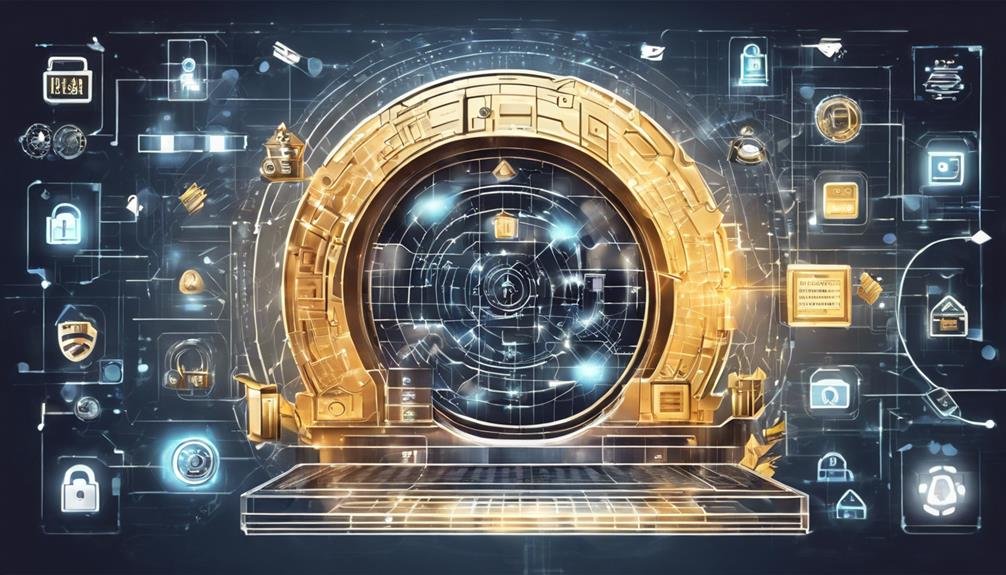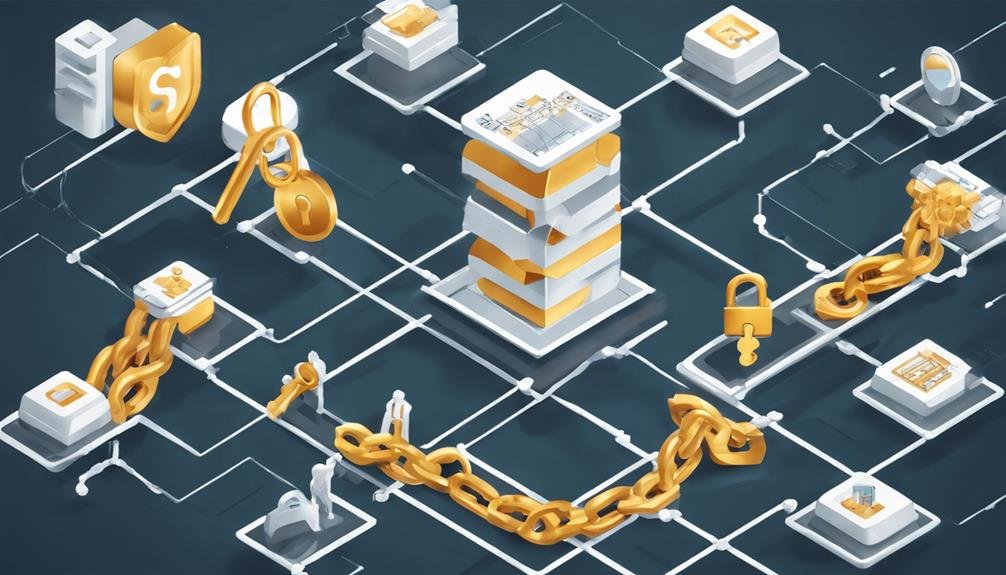Blockchain technology fortifies asset management security by employing cryptographic techniques to guarantee data protection, immutability for preventing data alteration, authentication mechanisms for secure access, decentralization to reduce single points of failure, and transparency for enhanced transaction tracking. Encryption methods such as AES and RSA add layers of security to asset data, safeguarding confidentiality, secure data transmission, and digital signature verification.
Implementing secure data storage with blockchain assures tamper-resistant data, safeguarding sensitive information through cryptographic security features. The technology also offers immutable records, automated verification processes, compliant transactions, and increased liquidity in the market, hinting at its extensive benefits for asset management security.
Brief Overview of Blockchain And Secure Asset Management
- Blockchain technology ensures secure and transparent transaction verification.
- Encryption techniques like AES and RSA safeguard asset data.
- Decentralization in blockchain reduces risks of data manipulation.
- Smart contracts automate secure data storage processes.
- Compliance with regulations is improved through blockchain transparency.
Importance of Blockchain Security in Asset Management
With the increasing value and sensitivity of assets in today’s digital landscape, understanding the crucial role of blockchain security in asset management is essential. Blockchain technology acts as a stronghold of security, utilizing cryptographic techniques to safeguard valuable assets. The immutability of blockchain records guarantees that once data is recorded, it cannot be modified, providing a tamper-resistant environment for asset management. Authentication mechanisms integrated within blockchain systems offer secure access control, enhancing overall security measures.
Furthermore, blockchain excels in decentralizing control, reducing the risks associated with single points of failure often found in traditional asset management systems. By distributing authority across a network of nodes, blockchain greatly lessens vulnerabilities, strengthening asset management processes’ security. Additionally, the transparency intrinsic in blockchain technology contributes to enhanced security, enabling stakeholders to verify and track transactions reliably. Embracing blockchain security in asset management is not just a choice but necessary to safeguard valuable assets effectively.
Encryption Techniques for Asset Security

Employing robust encryption techniques is essential to enhance asset security in blockchain management. Encryption techniques such as AES (Advanced Encryption Standard) and RSA (Rivest-Shamir-Adleman) significantly safeguard asset data within blockchain asset management systems. AES encryption, a symmetric key algorithm, is widely used for data security, ensuring that sensitive information remains confidential. On the other hand, RSA encryption, an asymmetric key algorithm, is important for secure data transmission and digital signature verification, adding layers of protection to asset data.
Implementing Secure Data Storage With Blockchain

Protecting your data storage with blockchain technology guarantees unparalleled protection and integrity for your asset management operations. Blockchain’s decentralized and immutable ledger system ensures that your data remains tamper-resistant, providing a secure environment for storing digital assets. By implementing secure data storage with blockchain, you can safeguard sensitive information related to asset management and prevent unauthorized access. Blockchain technology’s cryptographic security features enhance your data’s overall security, offering a level of protection that traditional storage methods cannot match.
Smart contracts, a key feature of blockchain, enable automated and secure data storage processes specifically designed for asset management purposes. This automation reduces the risk of human error and ensures that your data is stored safely and efficiently. In addition, utilizing blockchain for secure data storage enhances trust and transparency in your asset management operations, as all transactions are recorded on an immutable ledger, providing a clear audit trail for verification. Trust in the integrity of your data is paramount in asset management, and blockchain technology offers a reliable solution for maintaining that trust.
Secure Transaction Verification in Asset Management

Enhance the security of asset management operations by implementing secure transaction verification methods using cryptographic techniques like digital signatures. Blockchain technology offers immutable records, guaranteeing the integrity and authenticity of asset transactions. Asset managers can securely verify transactions through consensus mechanisms like proof of work or stake. Smart contracts enable automated verification of transaction conditions, reducing the risk of fraud and errors.
The decentralized nature of blockchain eliminates the need for a central authority to verify asset transactions, enhancing security and trust in the process. By leveraging digital signatures and smart contracts, asset managers can ensure that transactions meet predefined conditions and are securely validated without intermediaries. This automated verification process increases efficiency and minimizes the potential for human error or manipulation, further bolstering the security of asset management operations.
Enhancing Compliance With Blockchain Security

By harnessing blockchain security measures, you can ensure compliance with regulations and improve the transparency of asset management transactions. Blockchain technology guarantees secure and transparent data, aiding in regulatory compliance, such as anti-money laundering requirements. Implementing blockchain reduces compliance costs and errors by automating processes. It enhances data security, operational efficiency, and compliance in asset management, providing a robust framework for managing digital assets. Smart contracts, triggered by blockchain, enable faster transaction processing for asset managers, streamlining operations.
Moreover, asset tokenization through blockchain broadens the investor base. It increases liquidity in the market, offering more opportunities for asset owners. Overall, using blockchain technology not only strengthens data security but also simplifies compliance procedures, ultimately benefiting asset managers and investors alike.
Frequently Asked Questions
How Does Blockchain Help in Asset Management?
Blockchain contributes to asset management by providing transparency benefits through immutable recordkeeping. It enhances efficiency gains by automating processes with smart contracts. Fraud prevention is strengthened due to decentralized control and data verification. Automation advantages lead to cost savings, and trust is established through secure transactions. Overall, blockchain guarantees accountability and security, making asset management more reliable and secure for users seeking safety and integrity in their investments.
How Does Blockchain Ensure Security?
Data encryption in blockchain guarantees security by creating immutable records of transactions. Decentralized control and consensus mechanisms safeguard against unauthorized access and data manipulation. Digital signatures, smart contracts, and transparent transactions enhance security measures. Permissioned access and audit trails provide additional layers of protection, preventing fraud. Blockchain’s robust security features assure the integrity of asset management, offering peace of mind and reliability in safeguarding valuable assets.
How Does Blockchain Improve Cybersecurity?
Blockchain technology improves cybersecurity by utilizing data encryption, ensuring secure and encrypted information storage. Immutable records guarantee that once data is recorded, it remains unaltered, enhancing integrity. Decentralized control eliminates single points of failure, making it harder for hackers to compromise sensitive data. Smart contracts enable secure transactions with predefined conditions, reducing the risk of fraud. These features collectively enhance cybersecurity and promote safety in asset management processes.
What Are the Benefits of Dlt?
When examining the advantages of DLT, you’ll discover that it provides transparent tracking, unchangeable records, effective processes, fraud deterrence, heightened trust, minimized costs, improved accountability, decentralized control, efficient operations, and real-time updates. DLT guarantees a secure and dependable asset management system by leveraging these characteristics. So, even if you have doubts, be confident that DLT has you covered with its cutting-edge technology.
Conclusion
To sum up, blockchain technology offers a secure and efficient solution for asset management security. Organizations can enhance compliance and protect their valuable assets by utilizing encryption techniques, secure data storage, and transaction verification. So, next time you think about asset management, remember that blockchain is not just a chain of blocks but a fortress of security for your digital valuables. Stay safe and stay secure with blockchain!










